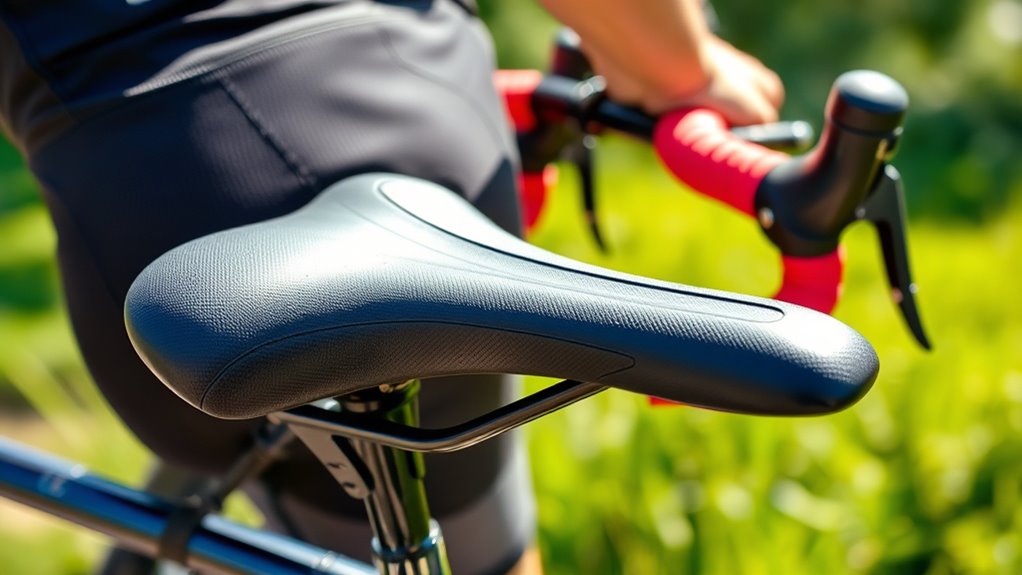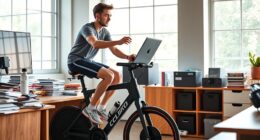To set up your bike for comfort, start by adjusting your saddle height so that your heel touches the pedal at the bottom with a nearly straight leg. Position your saddle forward or backward to align your knee over the pedal axle, and tilt it level for comfort. Set the handlebar height level with or slightly above your saddle for a relaxed reach. Small tweaks here and there can greatly improve your riding experience—continue to explore these adjustments for the best fit.
Key Takeaways
- Adjust saddle height so your heel touches the pedal at the lowest point with a nearly straight leg.
- Position the saddle fore-aft to align your knee over the pedal axle at 3 o’clock.
- Set handlebar height level with or slightly above the saddle for a relaxed riding posture.
- Fine-tune handlebar reach and drop to reduce strain and improve control, using spacers or ergonomic grips.
- Test ride after each adjustment, ensuring comfort, proper posture, and minimal fatigue during cycling.
Assessing Your Riding Style and Body Measurements
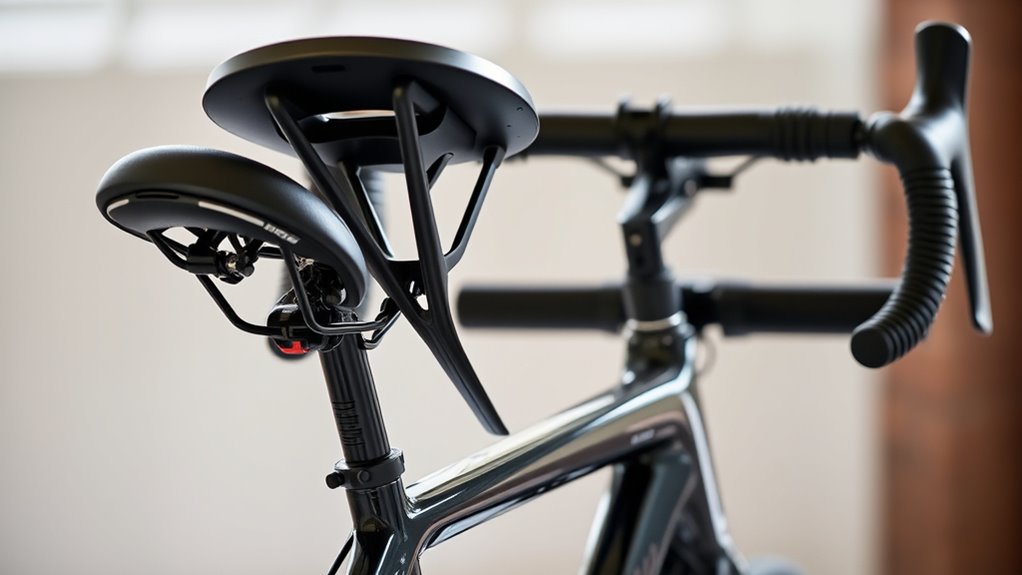
Before choosing the right bike setup, understanding your riding style and body measurements is vital. Your cycling posture influences how you should position your saddle and handlebars for comfort. If you prefer relaxed, leisurely rides, you’ll want a more upright posture, which requires different adjustments than aggressive, performance-focused riding. Body flexibility also plays a key role; if you’re highly flexible, you might comfortably reach lower handlebars, while limited flexibility calls for a more upright setup to avoid strain. Measure your inseam, torso length, and arm reach to guarantee proper fit. An accurate assessment of these factors helps you customize your bike’s components, reducing discomfort and preventing injury. Additionally, considering ergonomic bike design can further enhance comfort and reduce fatigue during long rides. Incorporating proper bike fitting techniques can optimize your riding position, promoting better alignment and comfort. Tailoring your setup to your unique body and style ensures a more enjoyable, efficient ride. For example, adjusting saddle height and handlebar position based on your body measurements can significantly improve overall comfort and performance. Being aware of the latest advancements in bike comfort technology can also contribute to a more personalized and enjoyable cycling experience. Regularly consulting with a professional bike fitter can help you stay updated on innovative adjustments that improve riding comfort.
Determining the Correct Saddle Height
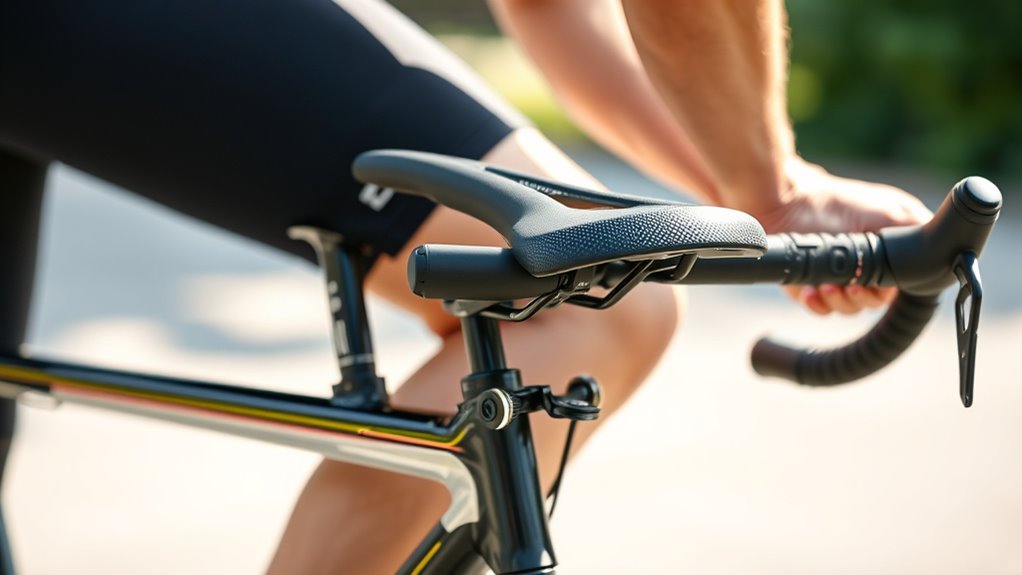
Setting your saddle height correctly is fundamental to riding comfortably and efficiently. To find the right height, sit on your bike and place your heel on the pedal at the lowest position; your leg should be almost straight. When you pedal normally, there should be a slight bend in your knee at the bottom of the stroke. Proper saddle height helps prevent discomfort and injury, and it works well with your bike accessories and cycling apparel, ensuring a snug fit. Adjusting bike components plays a crucial role in optimizing your riding position. For example, choosing the right tip size can influence your control and comfort during rides. Remember, a saddle that’s too high or too low can cause strain. Adjust incrementally and test ride to find your ideal position. Having the right saddle height enhances your riding experience and keeps you comfortable on longer rides. Additionally, understanding how market growth projections influence cycling technology can help you choose future-proof accessories.
Adjusting Saddle Fore-Aft Position for Optimal Comfort
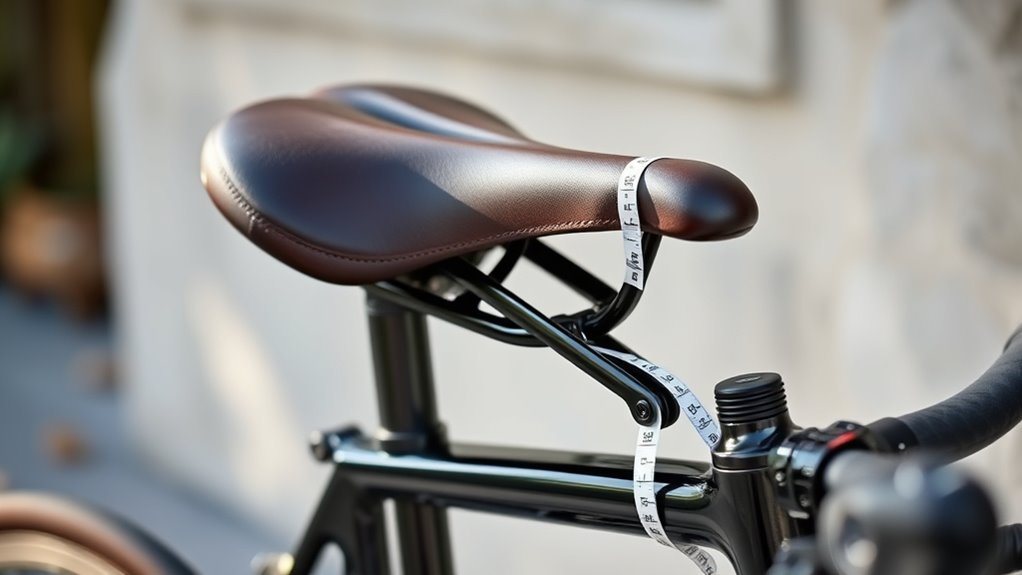
Adjusting your saddle fore-aft position is key to achieving ideal comfort and efficient pedaling. Start by sitting on your bike and placing your feet on the pedals. Move the saddle forward or backward until your knee aligns directly over the pedal axle when the pedal is at the 3 o’clock position. Proper saddle positioning can help prevent discomfort and improve your riding posture. Your saddle material can influence comfort—softer options might feel better, but they can also affect stability. Keep in mind that saddle aesthetics matter, but comfort takes priority. A properly positioned saddle reduces strain on your hips and knees, helping you ride longer without discomfort. Additionally, ergonomic saddle design can enhance overall riding comfort and support. Selecting the right saddle width and shape is also essential for long-term comfort during rides. Take your time fine-tuning this position, and test your setup on a short ride to ensure you’re comfortable and efficient. Small adjustments can make a big difference in your overall riding experience.
Setting the Handlebar Height for a Natural Reach
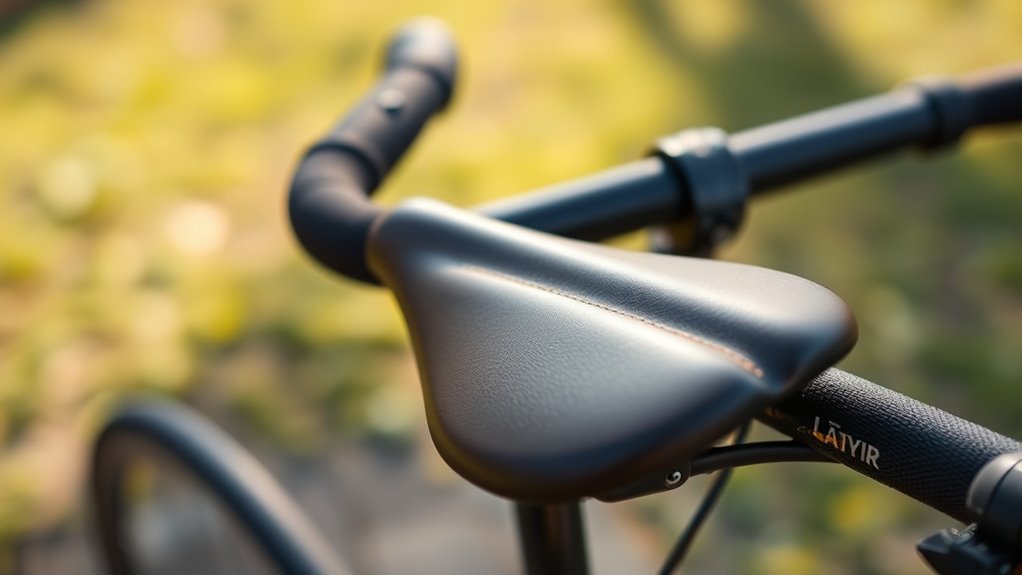
Once you’ve found a comfortable saddle position, the next step is to guarantee your handlebars promote a natural, relaxed reach. Adjusting handlebar height is key to reducing strain and improving comfort. Use ergonomic handlebars or adjustable stems to fine-tune your position easily. Incorporating ergonomic design can help you assess whether your adjustments are making a positive difference. Here are four tips:
Adjust handlebar height for a relaxed, strain-free riding position.
- Start with the handlebars level with or slightly above your saddle height for a relaxed posture.
- Use adjustable stems to modify height without replacing components.
- Ensure your elbows are slightly bent when gripping the handlebars, which can help maintain proper handlebar positioning.
- Test ride and make small adjustments until your reach feels natural and strain-free. Environmental considerations like proper setup can also contribute to a more comfortable ride by reducing unnecessary strain and promoting sustainable cycling habits. Additionally, ensuring correct handlebar positioning can prevent long-term discomfort and improve overall riding efficiency.
Proper handlebar height helps prevent neck and back tension and supports a more comfortable ride.
Fine-Tuning Handlebar Reach and Drop
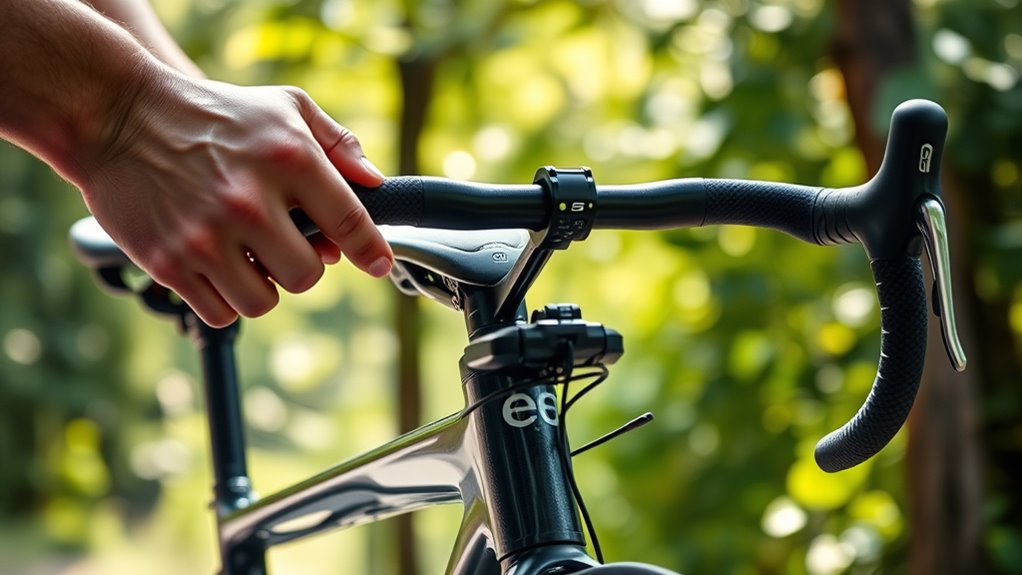
To achieve a comfortable and efficient riding position, you need to fine-tune your handlebar reach and drop. Adjusting these ensures less strain and better control. If you feel stretched out or cramped, modify the handlebar position or add ergonomic grips for comfort. Handlebar accessories like spacers or extensions can help customize your setup. Use the table below to identify your preferences: ergonomic design can further enhance comfort and reduce fatigue during long rides. Additionally, adjusting handlebar height can significantly impact your riding comfort and should be tailored to your body and riding style. Properly configuring your handlebar setup can also improve overall wall organization and make your riding experience more enjoyable. Considering the wave and wind conditions common at beaches can help you choose the best handlebar setup for your cycling environment, especially if you plan to ride near coastal areas. Consulting interior design principles can offer insights into creating an optimal bike fit that aligns with your personal comfort and riding goals.
Checking and Adjusting Saddle Tilt for Comfort and Efficiency
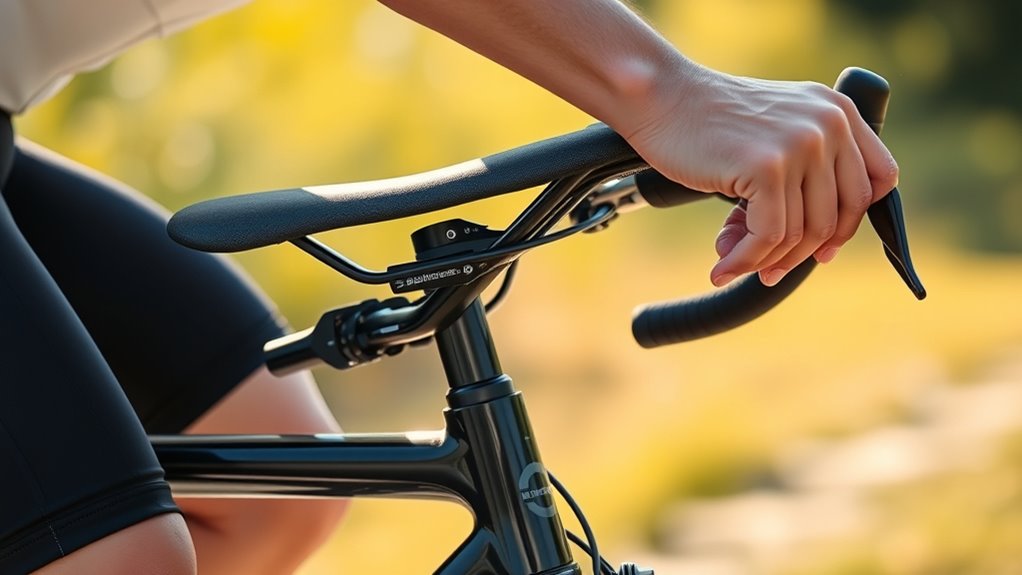
Have you ever noticed discomfort or instability while riding? Adjusting your saddle tilt can make a big difference in comfort and efficiency. The saddle tilt, or seat angle, affects how your weight distributes across the bike.
To check and adjust it:
- Sit on the saddle and observe its angle with a level or straight edge.
- If the nose tilts up or down, loosen the saddle clamp.
- Adjust the seat angle so that it’s level or slightly tilted downward for comfort.
- Tighten the clamp securely, then test ride to feel the difference.
Proper saddle tilt ensures you’re not putting unnecessary pressure on sensitive areas and helps maintain stability. Small modifications here can greatly improve your riding experience. Additionally, understanding the correct saddle height can also contribute to better posture and comfort during your ride.
Testing Your Setup and Making Small Adjustments
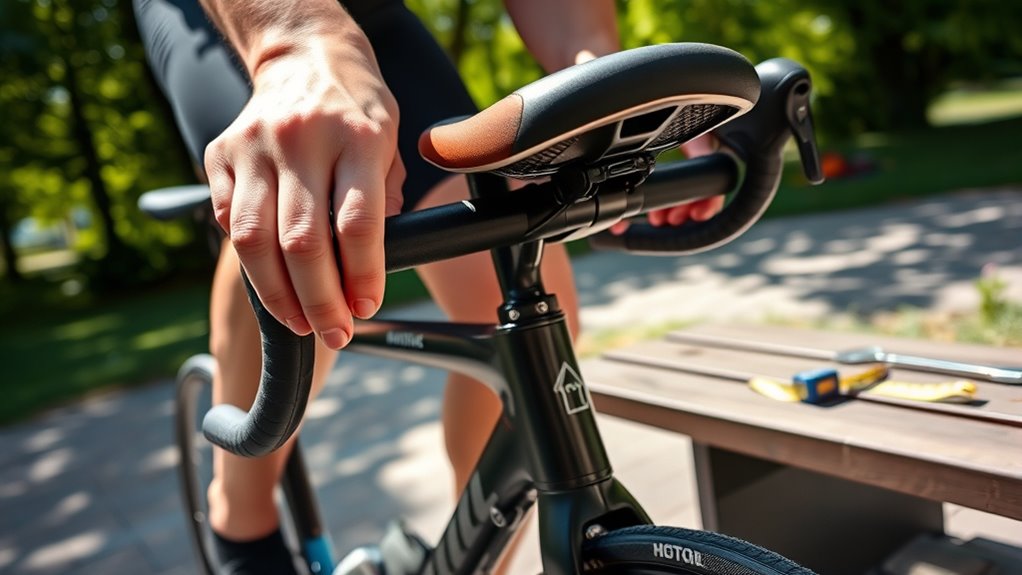
After making initial saddle adjustments, it’s essential to test your setup on a ride to see how it feels in real conditions. Pay attention to comfort, pedaling efficiency, and any signs of fatigue. Using essential oils such as lavender or peppermint in a diffuser or on your pulse points can help reduce stress and improve your focus during the ride. Incorporating proper bike fit techniques can further enhance your riding experience and reduce the risk of discomfort. Use your bike accessories, like padded gloves or ergonomic grips, to enhance comfort during the test ride. Clothing choices also matter—wear moisture-wicking fabrics and appropriate padding to stay comfortable. As you ride, notice if you need to raise or lower your saddle slightly or adjust handlebar position for better reach and control. Small tweaks can make a significant difference, so don’t hesitate to make minor adjustments based on your experience. Take note of how each change affects your ride, ensuring your setup is optimized for comfort and performance.
Recognizing Signs of Poor Fit During Rides
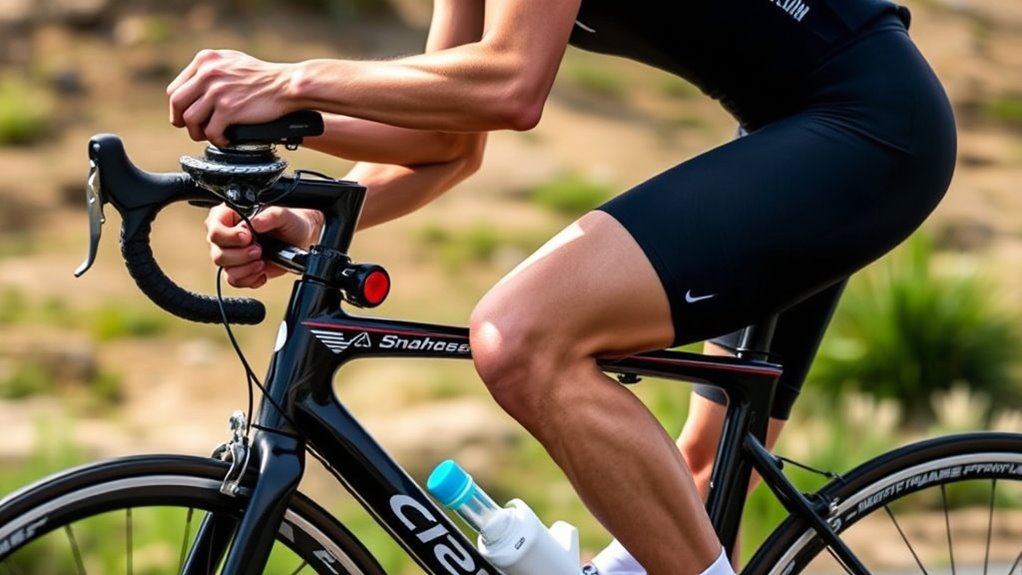
Recognizing signs of poor fit during your ride is essential to prevent discomfort and potential injury. When your bike isn’t properly adjusted, you may notice issues that affect your performance and safety.
Common signs include persistent numbness or tingling, especially in your hands or groin area; excessive fatigue or muscle soreness that doesn’t improve with rest; discomfort in your knees, back, or neck; and difficulty maintaining steady cycling nutrition, leading to fatigue.
Additionally, poor fit can cause you to adjust your bike constantly, increasing wear and tear from bike maintenance. If you experience any of these signs, it’s a cue to reassess your saddle height, handlebar position, and overall setup.
Prompt adjustments can improve comfort and efficiency on every ride.
Maintaining and Reassessing Your Bike Fit Over Time
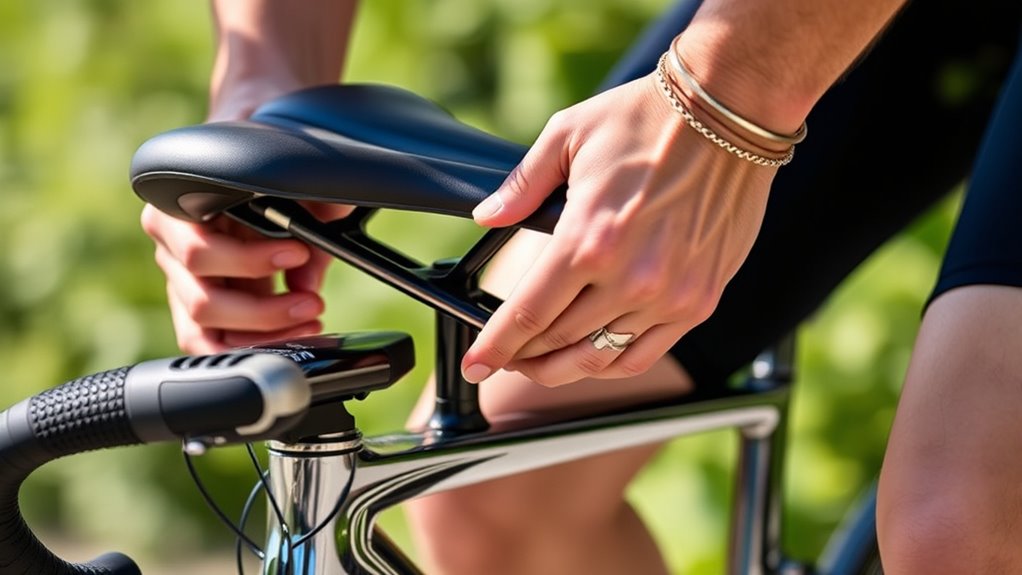
Once you’ve identified and corrected any issues with your bike fit, it’s important to remember that your body and riding habits can change over time. Regularly reassessing your fit guarantees continued comfort and efficiency.
Proper bike storage helps protect your bike from weather and damage, preventing misalignments. Incorporate cleaning maintenance into your routine to spot wear or loosened components that could affect fit.
If you notice discomfort, numbness, or pain, it’s time to reevaluate saddle height, handlebar position, or other adjustments. As your flexibility or strength evolves, your bike setup may need tweaking.
Staying attentive to these changes keeps your ride comfortable and prevents injury, making regular check-ins a key part of long-term bike care.
Frequently Asked Questions
How Often Should I Revisit My Bike Fit Adjustments?
You should revisit your bike fit adjustments whenever your riding posture changes or if you notice discomfort. Regularly checking your ergonomic seating guarantees ideal comfort and efficiency.
Typically, every few months or after significant rides, take time to reassess your saddle height and handlebar position. This helps maintain proper alignment, prevent injuries, and keep your riding experience enjoyable, especially as your flexibility and strength evolve over time.
Can Improper Saddle Height Cause Long-Term Injury?
Think of your saddle like a foundation—if it’s off, everything above suffers. Improper saddle height can turn minor saddle pain into a long-term injury risk, like a small crack spreading through a wall.
Over time, this misalignment strains your knees, hips, and back, increasing injury chances. So, don’t ignore the signs; fine-tune your saddle height to keep your ride smooth and safe, avoiding future pain and damage.
What’s the Best Way to Check Handlebar Reach During Rides?
To check your handlebar reach during rides, focus on maintaining an ergonomic grip that feels comfortable and natural.
Use reach measurement techniques, like measuring the distance from your saddle to the handlebars, to guarantee proper positioning.
Pay attention to any strain on your neck, shoulders, or back.
Adjust the handlebar position if needed, so you can ride comfortably and avoid long-term discomfort or injury.
How Do I Accommodate Changes in Flexibility Over Time?
To accommodate changes in your flexibility over time, regularly incorporate flexibility exercises into your routine. These help maintain or improve your range of motion, making cycling more comfortable.
Also, consider ergonomic accessories like adjustable handlebars or padded saddles that can be fine-tuned as your flexibility shifts. Staying attentive to your body’s signals and making small adjustments guarantees your bike setup remains comfortable and supportive, preventing strain or injury.
Are There Specific Tools Recommended for Precise Adjustments?
When you look for tool options for precise adjustments, there are a few essentials. You might consider a torque wrench for accurate tightening, a level to ensure proper handlebar alignment, and a ruler or measuring tape for saddle height.
Use adjustment techniques like measuring from specific points and referencing manufacturer guidelines. These tools and methods help you fine-tune your bike for maximum comfort and performance.
Conclusion
Now that you’ve fine-tuned your saddle height, handlebar position, and tilt, you’re ready to enjoy a more comfortable ride. Keep listening to your body, stay attentive to how you feel during each ride, and make small adjustments as needed. Remember, your bike fit isn’t a one-time setup but an ongoing process. Stay proactive, stay comfortable, and keep pedaling confidently—because a perfect fit leads to happier rides every time.
